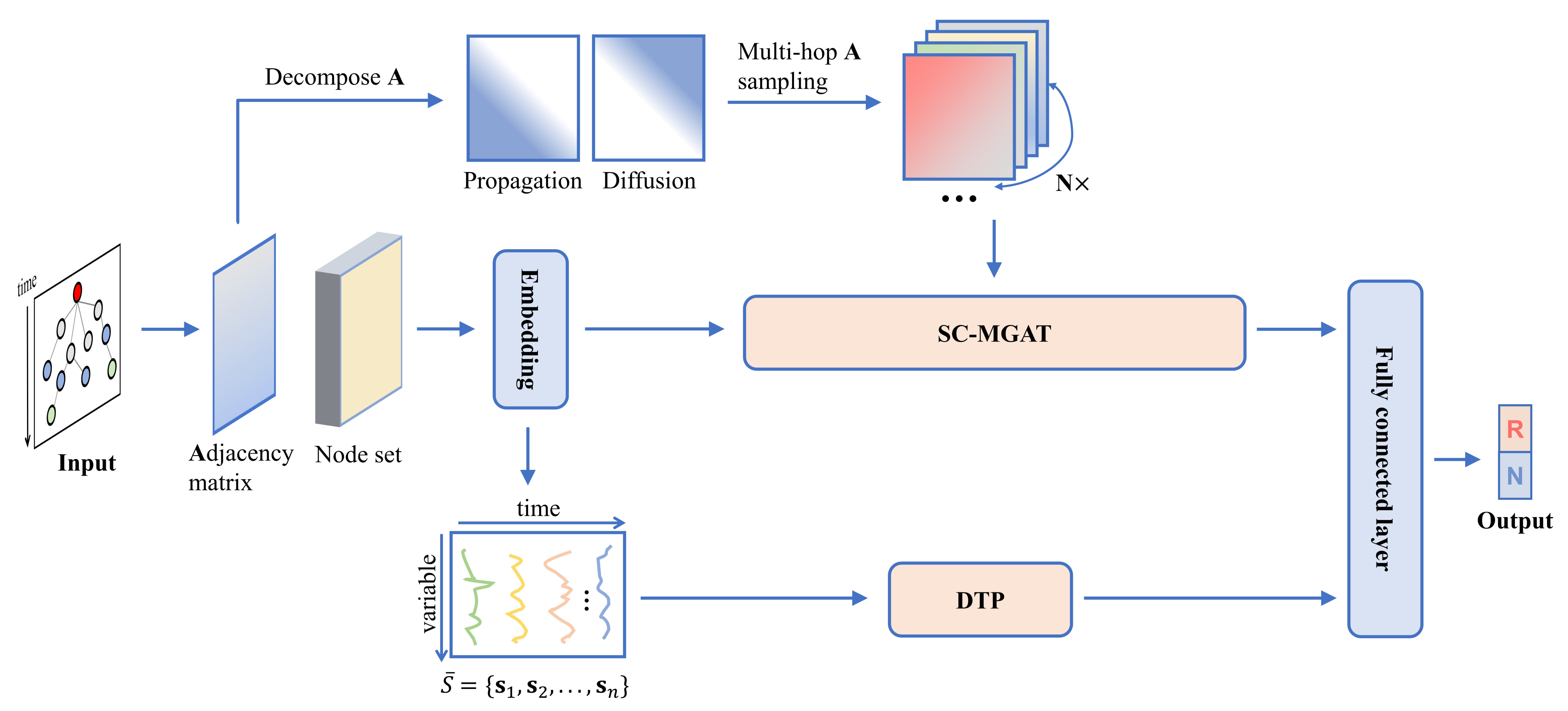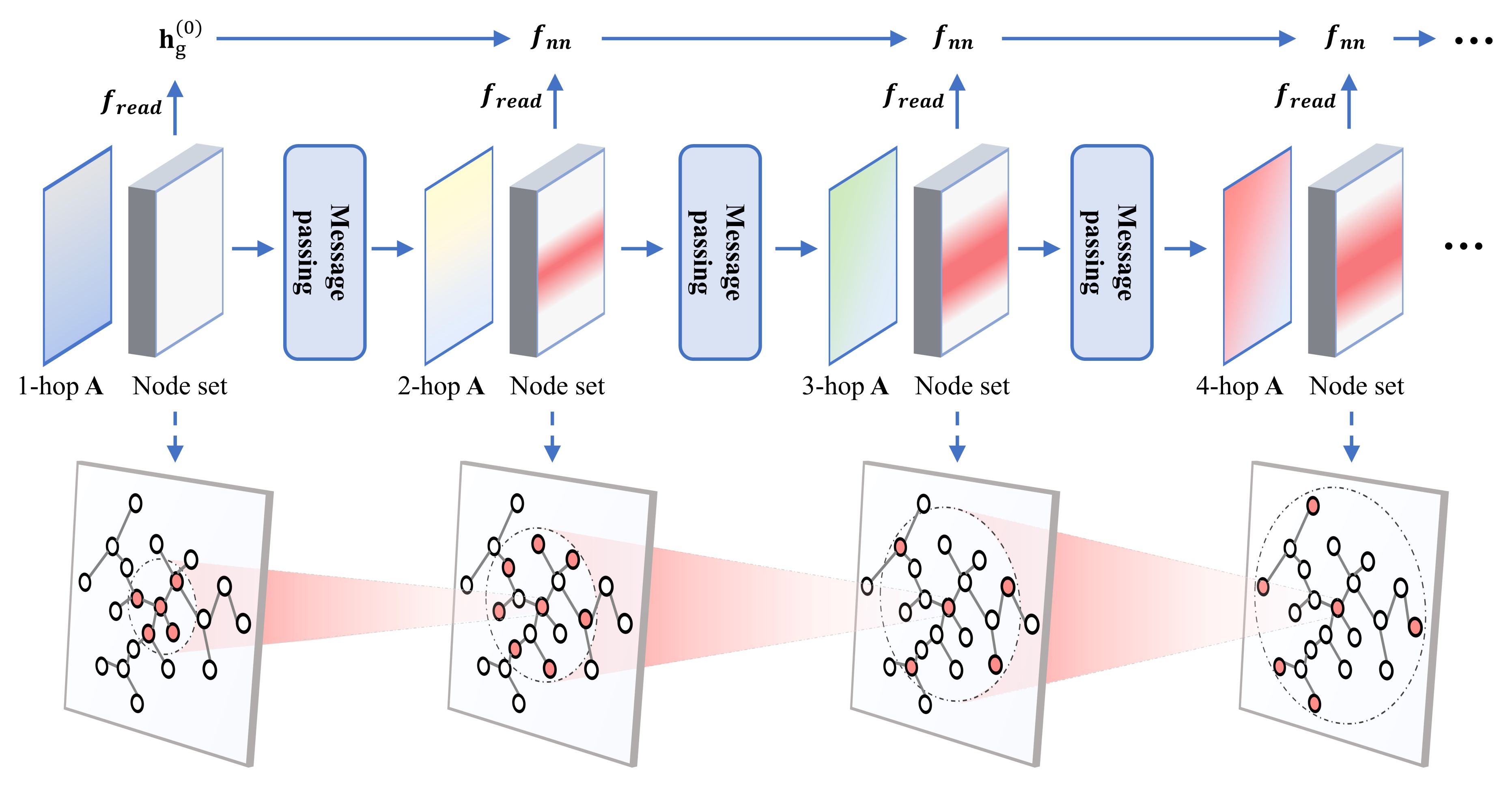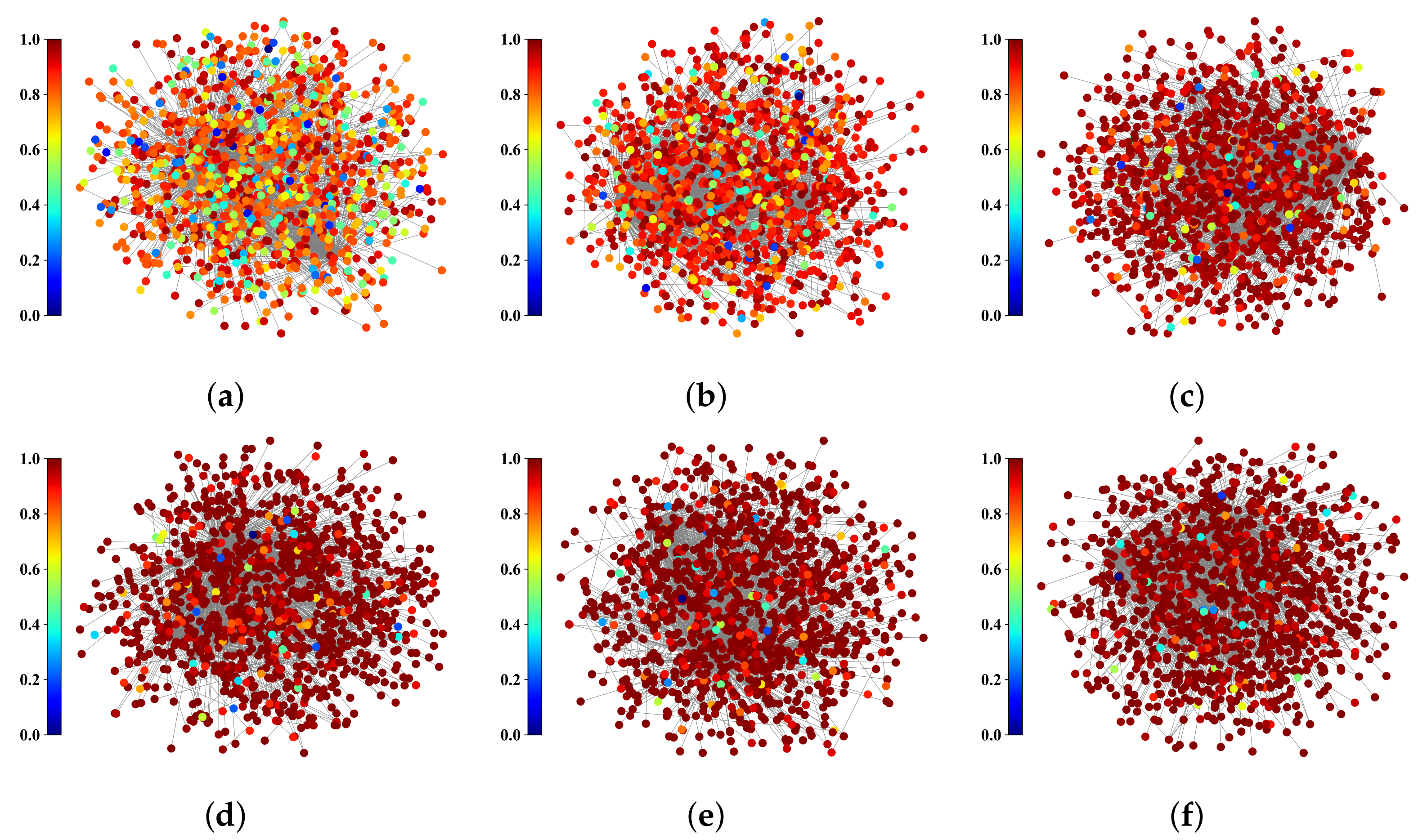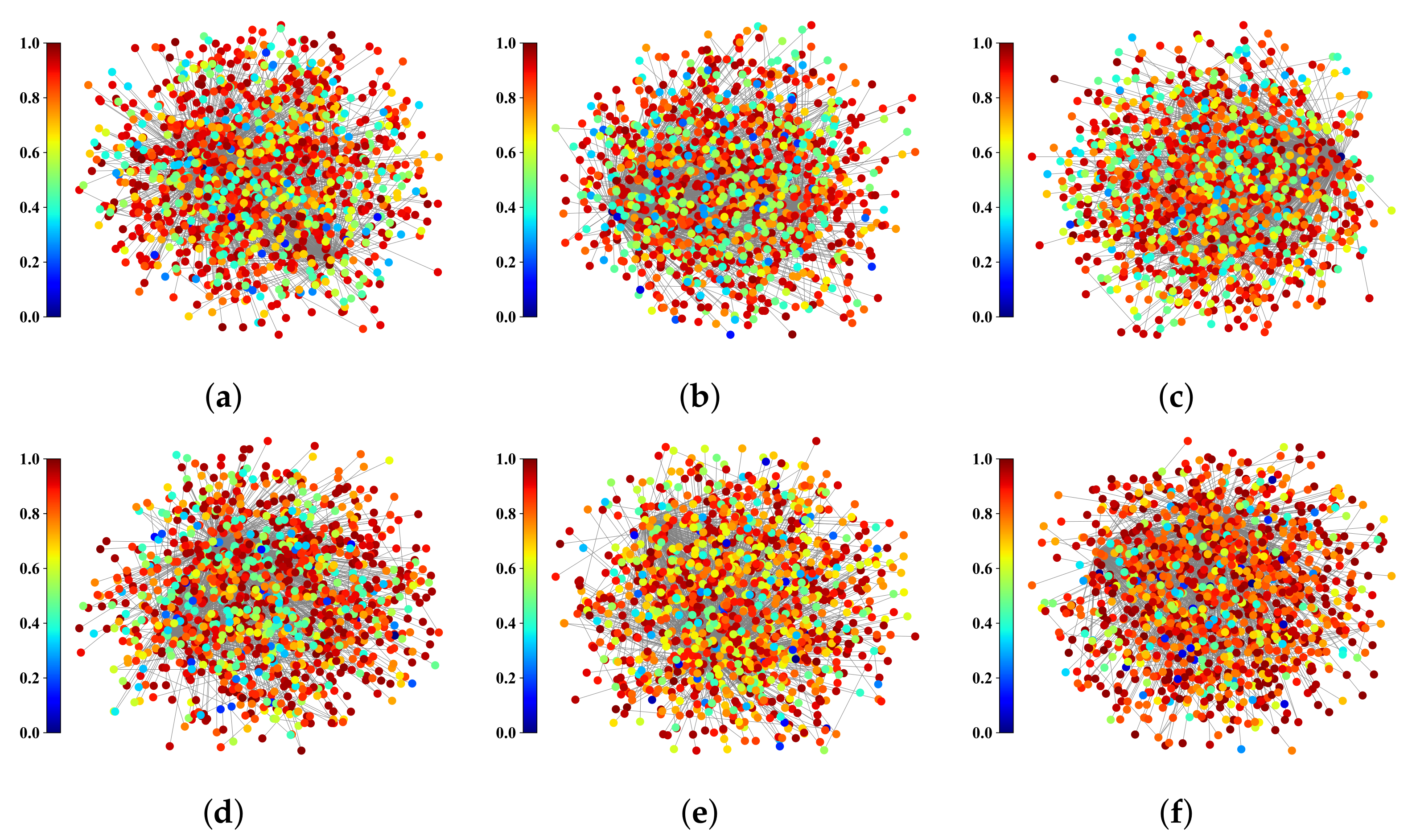Rumor Detection in Social Media Based on Multi-Hop Graphs and Differential Time Series
Abstract
1. Introduction
- This paper proposes a novel SMGaDTP model for rumor detection tasks. Compared with previous works, this model has the capability to simultaneously learn both the deep structural features and temporal features of rumors.
- The SC-MGAT is proposed in this paper, which builds upon the multi-hop graph and incorporates an enhanced message-passing framework to aggregate extensive neighborhood information. Additionally, a self-connected readout mechanism is introduced to achieve hierarchical extraction of global information.
- DTP is proposed in this paper, which models events from the perspective of differential time series to characterize the temporal variations of events. Based on this, a novel local window attention mechanism and GRU are employed to learn temporal features.
- Extensive experiments on real-world datasets demonstrate that the proposed methods outperform the previous state-of-the-art approaches. Further experiments also indicate that the SC-MGAT exhibits a significant improvement over traditional GNNs in addressing the oversmoothing problem.
2. Related Work
2.1. Text-Based Rumor Detection
2.2. Propagation-Based Rumor Detection
3. Problem Statement
4. Model
4.1. Model Framework
4.2. Embedding Layer
4.3. Self Connected Multi-Hop Graph Attention Network (SC-MGAT)
4.3.1. Multi-Hop Graph Attention Network (Multi-Hop GAT)
4.3.2. Self-Connected Aggregation (SCA)
| Algorithm 1 SC-MGAT |
|
4.4. Differential Temporal Perception (DTP)
4.5. Classification Layer
5. Experiments
5.1. Datasets and Preprocessing
- Weibo: Initially proposed in [7], data were captured from Sina Weibo, a popular online social media platform in China. This dataset contains comprehensive event information, including text, timestamps, and user configurations, all stored in the JSON file format. It consists a total of 2351 real news and 2312 fake news instances.
- Twitter 15 and Twitter 16: First introduced in [38], data were collected from the widely used online social networking platform Twitter. Each dataset consists of news events categorized into four classes: unverified, non-rumor, true, and false. These datasets include only the IDs of the tweets. We collected additional information such as reply texts and timestamps using the Twitter API.
5.2. Baselines
- SVM-RBF [5]: A method based on SVM with a radial basis function (RBF) kernel. It utilizes a range of statistical features from tweets to identify fake news.
- SVM-TS [6]: A linear SVM-based classifier that employs time series modeling techniques to capture the temporal features of rumors.
- GCN [59]: A graph representation learning method that uses message passing to aggregate information from neighboring nodes for feature extraction.
- GAT [49]: An advanced graph representation learning framework. Similar to a GCN, it incorporates attention mechanisms to differentiate the importance of different nodes.
- BU-RvNN [9]: A rumor classification method based on bottom-up recursive neural networks. It integrates text content and propagation structure features using GRUs and performs classification based on the state of the root node.
- TD-RvNN [9]: A rumor classification method based on top-down recursive neural networks. It integrates text content and propagation structure features using GRUs and performs classification based on the state of the leaf nodes.
- STS-NN [13]: A rumor detection method based on deep spatiotemporal neural networks. It integrates rumor propagation and temporal features within a GRU-like unit for learning.
- BiGCN [11]: A model based on GCNs that models rumor events separately using propagation and diffusion structures, followed by a Bidirectional GCN for feature extraction.
5.3. Experimental Set-Up
5.4. Experimental Results and Analysis
5.4.1. Comparison of Model Performance
- Overall, our model outperformed other baseline methods in all datasets. On the Weibo dataset, our model improved the Acc and F1 by 1.39% and 1.42%, respectively, compared with the best baseline. On the Twitter dataset, the improvements were 3.51% and 3.57%, respectively. This confirms that our model effectively extracted more features compared with the baseline models, demonstrating the importance of high-order neighbor interaction features and differential temporal information in rumor detection tasks.
- The traditional machine learning-based methods exhibited lower performance across all datasets compared with the deep learning-based methods. This is because traditional methods rely on manually selected features, while deep learning algorithms can capture complex high-order features. Moreover, traditional machine learning only utilizes statistical-level features for text content, making it difficult to model semantic information.
- Consistent with [9] and others’ findings, BU-RvNN performed worse than TD-RvNN. This is because BU-RvNN compresses features into a single node representation, resulting in significant information loss. In contrast, TD-RvNN performs pooling on all leaf nodes to obtain the final features, thereby retaining more useful information. STS-NN utilizes both temporal and structural features simultaneously, but it still failed to achieve satisfactory results. This is partly due to compressing all the information into the last node.
- Among all the baseline models, BiGCN demonstrated stronger performance. Despite not utilizing temporal information, its ability to extract propagation and diffusion features enabled better structural information learning compared with STS-NN and TD-RvNN. However, the lack of high-order neighbor information (stacking only two layers of the GCN, capturing at most the interaction features of the two-hop neighbors) and the lack of temporal information restricted its performance.
5.4.2. Ablation Study
- SMGaDTP w/o SC-MGAT: This variant removes the SC-MGAT module and retains only the DTP module.
- SMGaDTP w/o DTP: This variant removes the DTP module and retains only the SC-MGAT module.
- SMGaDTP w/o DTP + SCA: This variant removes both the DTP and SCA modules, retaining only the Multi-hop GAT module.
- Overall, SMGaDTP performed better than the other variants on all datasets, indicating that all the proposed modules play indispensable roles in rumor detection tasks.
- By comparing the w/o SC-MGAT, w/o DTP, and SMGaDTP variants, it can be observed that the w/o SC-MGAT variant performed the worst among all the variants, while the w/o DTP variant performed the best. This suggests that the structural features of rumors are more significant than temporal features, and the SC-MGAT module effectively captured the structural features of the rumors.
- By comparing the w/o DTP and w/o DTP + SCA variants, it can be inferred that the SCA module plays an important role in SC-MGAT, enhancing its ability to learn high-order neighbor information.
5.4.3. Comparison of Early Detection
5.4.4. Comparison of Deep Graph Detection
6. Conclusions
Author Contributions
Funding
Institutional Review Board Statement
Informed Consent Statement
Data Availability Statement
Acknowledgments
Conflicts of Interest
References
- Sharma, K.; Qian, F.; Jiang, H.; Ruchansky, N.; Zhang, M.; Liu, Y. Combating Fake News: A Survey on Identification and Mitigation Techniques. ACM Trans. Intell. Syst. Technol. 2019, 10, 1–42. [Google Scholar] [CrossRef]
- Guo, B.; Ding, Y.; Yao, L.; Liang, Y.; Yu, Z. The Future of False Information Detection on Social Media: New Perspectives and Trends. ACM Comput. Surv. 2020, 53, 1–36. [Google Scholar] [CrossRef]
- Castillo, C.; Mendoza, M.; Poblete, B. Information Credibility on Twitter. In Proceedings of the 20th International Conference on World Wide Web, Hyderabad, India, 28 March–1 April 2011; pp. 675–684. [Google Scholar] [CrossRef]
- Kwon, S.; Cha, M.; Jung, K.; Chen, W.; Wang, Y. Prominent Features of Rumor Propagation in Online Social Media. In Proceedings of the 2013 IEEE 13th International Conference on Data Mining, Dallas, TX, USA, 7–10 December 2013; pp. 1103–1108. [Google Scholar] [CrossRef]
- Yang, F.; Liu, Y.; Yu, X.; Yang, M. Automatic Detection of Rumor on Sina Weibo. In Proceedings of the ACM SIGKDD Workshop on Mining Data Semantics, Beijing, China, 12–16 August 2012; pp. 1–7. [Google Scholar] [CrossRef]
- Ma, J.; Gao, W.; Wei, Z.; Lu, Y.; Wong, K.F. Detect Rumors Using Time Series of Social Context Information on Microblogging Websites. In Proceedings of the 24th ACM International on Conference on Information and Knowledge Management, Melbourne, VIC, Australia, 18–23 October 2015; pp. 1751–1754. [Google Scholar] [CrossRef]
- Ma, J.; Gao, W.; Mitra, P.; Kwon, S.; Jansen, B.J.; Wong, K.F.; Cha, M. Detecting Rumors from Microblogs with Recurrent Neural Networks. In Proceedings of the Twenty-Fifth International Joint Conference on Artificial Intelligence, New York, NY, USA, 9–15 July 2016; pp. 3818–3824. [Google Scholar]
- Yu, F.; Liu, Q.; Wu, S.; Wang, L.; Tan, T. A Convolutional Approach for Misinformation Identification. In Proceedings of the 26th International Joint Conference on Artificial Intelligence, Melbourne, VIC, Australia, 19–25 August 2017; pp. 3901–3907. [Google Scholar] [CrossRef]
- Ma, J.; Gao, W.; Wong, K.F. Rumor Detection on Twitter with Tree-structured Recursive Neural Networks. In Proceedings of the 56th Annual Meeting of the Association for Computational Linguistics (Volume 1: Long Papers), Melbourne, VIC, Australia, 15–20 July 2018; pp. 1980–1989. [Google Scholar] [CrossRef]
- Monti, F.; Frasca, F.; Eynard, D.; Mannion, D.; Bronstein, M.M. Fake news detection on social media using geometric deep learning. arXiv 2019, arXiv:1902.06673. [Google Scholar]
- Bian, T.; Xiao, X.; Xu, T.; Zhao, P.; Huang, W.; Rong, Y.; Huang, J. Rumor Detection on Social Media with Bi-Directional Graph Convolutional Networks. In Proceedings of the AAAI Conference on Artificial Intelligence, New York, NY, USA, 7–12 February 2020; pp. 549–556. [Google Scholar] [CrossRef]
- Lin, H.; Zhang, X.; Fu, X. A Graph Convolutional Encoder and Decoder Model for Rumor Detection. In Proceedings of the 2020 IEEE 7th International Conference on Data Science and Advanced Analytics (DSAA), Sydney, NSW, Australia, 6–9 October 2020; pp. 300–306. [Google Scholar] [CrossRef]
- Huang, Q.; Zhou, C.; Wu, J.; Liu, L.; Wang, B. Deep spatial–temporal structure learning for rumor detection on Twitter. Neural Comput. Appl. 2020, 35, 12995–13005. [Google Scholar] [CrossRef]
- Zhao, L.; Akoglu, L. Pairnorm: Tackling oversmoothing in gnns. arXiv 2019, arXiv:1909.12223. [Google Scholar]
- Li, G.; Muller, M.; Thabet, A.; Ghanem, B. Deepgcns: Can gcns go as deep as cnns? In Proceedings of the 2019 IEEE/CVF International Conference on Computer Vision (ICCV), Seoul, Republic of Korea, 29 October–2 November 2019; pp. 9267–9276. [Google Scholar] [CrossRef]
- Choi, J.; Ko, T.; Choi, Y.; Byun, H.; Kim, C.k. Dynamic graph convolutional networks with attention mechanism for rumor detection on social media. PLoS ONE 2021, 16, e0256039. [Google Scholar] [CrossRef]
- Song, C.; Shu, K.; Wu, B. Temporally evolving graph neural network for fake news detection. Inf. Process. Manag. 2021, 58, 102712. [Google Scholar] [CrossRef]
- Song, C.; Teng, Y.; Zhu, Y.; Wei, S.; Wu, B. Dynamic graph neural network for fake news detection. Neurocomputing 2022, 505, 362–374. [Google Scholar] [CrossRef]
- Sun, M.; Zhang, X.; Zheng, J.; Ma, G. Ddgcn: Dual dynamic graph convolutional networks for rumor detection on social media. In Proceedings of the AAAI Conference on Artificial Intelligence, Online, 22 February–1 March 2022; pp. 4611–4619. [Google Scholar] [CrossRef]
- Chen, T.; Li, X.; Yin, H.; Zhang, J. Call attention to rumors: Deep attention based recurrent neural networks for early rumor detection. In Proceedings of the Trends and Applications in Knowledge Discovery and Data Mining: PAKDD 2018 Workshops, Melbourne, VIC, Australia, 3 June 2018; pp. 40–52. [Google Scholar] [CrossRef]
- Wang, Z.; Guo, Y.; Li, Z.; Tang, M.; Qi, T.; Wang, J. Research on microblog rumor events detection via dynamic time series based GRU model. In Proceedings of the ICC 2019-2019 IEEE International Conference on Communications (ICC), Shanghai, China, 20–24 May 2019; pp. 1–6. [Google Scholar] [CrossRef]
- Fournier, L.; Dupoux, E.; Dunbar, E. Analogies minus analogy test: Measuring regularities in word embeddings. arXiv 2020, arXiv:2010.03446. [Google Scholar]
- Puccetti, G.; Miaschi, A.; Dell’Orletta, F. How Do BERT Embeddings Organize Linguistic Knowledge? In Proceedings of the Deep Learning Inside out (DeeLIO): The 2nd Workshop on Knowledge Extraction and Integration for Deep Learning Architectures, Online, 20–24 June 2021; pp. 48–57. [Google Scholar] [CrossRef]
- Dalvi, F.; Durrani, N.; Sajjad, H.; Belinkov, Y.; Bau, A.; Glass, J. What Is One Grain of Sand in the Desert? Analyzing Individual Neurons in Deep NLP Models. In Proceedings of the AAAI Conference on Artificial Intelligence, Honolulu, HI, USA, 27 January–1 February 2019; pp. 6309–6317. [Google Scholar] [CrossRef]
- Durrani, N.; Sajjad, H.; Dalvi, F.; Belinkov, Y. Analyzing individual neurons in pre-trained language models. arXiv 2020, arXiv:2010.02695. [Google Scholar]
- Rong, Y.; Huang, W.; Xu, T.; Huang, J. The truly deep graph convolutional networks for node classification. arXiv 2019, arXiv:1907.10903. [Google Scholar]
- Takahashi, T.; Igata, N. Rumor detection on twitter. In Proceedings of the 6th International Conference on Soft Computing and Intelligent Systems, and the 13th International Symposium on Advanced Intelligence Systems, Kobe, Japan, 20–24 November 2012; pp. 452–457. [Google Scholar] [CrossRef]
- Ratkiewicz, J.; Conover, M.; Meiss, M.; Gonçalves, B.; Patil, S.; Flammini, A.; Menczer, F. Detecting and tracking the spread of astroturf memes in microblog streams. arXiv 2010, arXiv:1011.3768. [Google Scholar]
- Yang, Y.; Zheng, L.; Zhang, J.; Cui, Q.; Li, Z.; Yu, P.S. TI-CNN: Convolutional neural networks for fake news detection. arXiv 2018, arXiv:1806.00749. [Google Scholar]
- Shu, K.; Cui, L.; Wang, S.; Lee, D.; Liu, H. defend: Explainable fake news detection. In Proceedings of the 25th ACM SIGKDD International Conference on Knowledge Discovery & Data Mining, Anchorage, AK, USA, 4–8 August 2019; pp. 395–405. [Google Scholar] [CrossRef]
- Khoo, L.M.S.; Chieu, H.L.; Qian, Z.; Jiang, J. Interpretable Rumor Detection in Microblogs by Attending to User Interactions. In Proceedings of the AAAI Conference on Artificial Intelligence, New York, NY, USA, 7–12 February 2020; pp. 8783–8790. [Google Scholar] [CrossRef]
- Hosseinimotlagh, S.; Papalexakis, E.E. Unsupervised content-based identification of fake news articles with tensor decomposition ensembles. In Proceedings of the Workshop on Misinformation and Misbehavior Mining on the Web (MIS2), Los Angeles, CA, USA, 9 February 2018. [Google Scholar]
- Wang, Y.; Ma, F.; Jin, Z.; Yuan, Y.; Xun, G.; Jha, K.; Su, L.; Gao, J. Eann: Event adversarial neural networks for multi-modal fake news detection. In Proceedings of the 24th ACM SIGKDD International Conference on Knowledge Discovery & Data Mining, London, UK, 19–23 August 2018; pp. 849–857. [Google Scholar] [CrossRef]
- Gautam, A.; Venktesh, V.; Masud, S. Fake news detection system using xlnet model with topic distributions: Constraint@ aaai2021 shared task. In Proceedings of the CONSTRAINT Shared Task in AAAI-2021, Online, 8 February 2018; pp. 189–200. [Google Scholar] [CrossRef]
- Ghanem, B.; Ponzetto, S.P.; Rosso, P.; Rangel, F. Fakeflow: Fake news detection by modeling the flow of affective information. arXiv 2021, arXiv:2101.09810. [Google Scholar]
- Yang, Z.; Dai, Z.; Yang, Y.; Carbonell, J.; Salakhutdinov, R.R.; Le, Q.V. Xlnet: Generalized autoregressive pretraining for language understanding. In Proceedings of the 33rd International Conference on Neural Information Processing Systems, Vancouver, BC, Canada, 8–14 December 2019; pp. 5753–5763. [Google Scholar]
- Zhang, X.; Cao, J.; Li, X.; Sheng, Q.; Zhong, L.; Shu, K. Mining Dual Emotion for Fake News Detection. In Proceedings of the Web Conference 2021, Ljubljana, Slovenia, 19–23 April 2021; pp. 3465–3476. [Google Scholar] [CrossRef]
- Ma, J.; Gao, W.; Wong, K.F. Detect rumors in microblog posts using propagation structure via kernel learning. In Proceedings of the 55th Annual Meeting of the Association for Computational Linguistics (Volume 1: Long Papers), Vancouver, BC, Canada, 30 July–4 August 2017; pp. 708–717. [Google Scholar] [CrossRef]
- Benamira, A.; Devillers, B.; Lesot, E.; Ray, A.K.; Saadi, M.; Malliaros, F.D. Semi-Supervised Learning and Graph Neural Networks for Fake News Detection. In Proceedings of the 2019 IEEE/ACM International Conference on Advances in Social Networks Analysis and Mining, Vancouver, BC, Canada, 27–30 August 2019; pp. 568–569. [Google Scholar] [CrossRef]
- Yuan, C.; Ma, Q.; Zhou, W.; Han, J.; Hu, S. Jointly embedding the local and global relations of heterogeneous graph for rumor detection. In Proceedings of the 2019 IEEE International Conference on Data Mining (ICDM), Beijing, China, 8–11 November 2019; pp. 796–805. [Google Scholar] [CrossRef]
- Huang, Q.; Yu, J.; Wu, J.; Wang, B. Heterogeneous Graph Attention Networks for Early Detection of Rumors on Twitter. In Proceedings of the 2020 International Joint Conference on Neural Networks (IJCNN), Glasgow, UK, 19–24 July 2020; pp. 1–8. [Google Scholar] [CrossRef]
- Tu, K.; Chen, C.; Hou, C.; Yuan, J.; Li, J.; Yuan, X. Rumor2vec: A rumor detection framework with joint text and propagation structure representation learning. Inf. Sci. 2021, 560, 137–151. [Google Scholar] [CrossRef]
- Dong, M.; Zheng, B.; Quoc Viet Hung, N.; Su, H.; Li, G. Multiple Rumor Source Detection with Graph Convolutional Networks. In Proceedings of the 28th ACM International Conference on Information and Knowledge Management, Beijing, China, 3–7 November 2019; pp. 569–578. [Google Scholar] [CrossRef]
- Xu, K.; Hu, W.; Leskovec, J.; Jegelka, S. How powerful are graph neural networks? arXiv 2018, arXiv:1810.00826. [Google Scholar]
- Chen, Y.; You, J.; He, J.; Lin, Y.; Peng, Y.; Wu, C.; Zhu, Y. SP-GNN: Learning structure and position information from graphs. Neural Netw. 2023, 161, 505–514. [Google Scholar] [CrossRef]
- You, J.; Gomes-Selman, J.M.; Ying, R.; Leskovec, J. Identity-aware Graph Neural Networks. In Proceedings of the AAAI Conference on Artificial Intelligence, Online, 2–9 February 2021; pp. 10737–10745. [Google Scholar] [CrossRef]
- He, K.; Zhang, X.; Ren, S.; Sun, J. Deep residual learning for image recognition. In Proceedings of the IEEE Conference on Computer Vision and Pattern Recognition, Las Vegas, NV, USA, 27–30 June 2016; pp. 770–778. [Google Scholar] [CrossRef]
- Xue, H.; Sun, X.K.; Sun, W.X. Multi-hop hierarchical graph neural networks. In Proceedings of the 2020 IEEE International Conference on Big Data and Smart Computing (BigComp), Busan, Republic of Korea, 19–22 February 2020; pp. 82–89. [Google Scholar] [CrossRef]
- Veličković, P.; Cucurull, G.; Casanova, A.; Romero, A.; Lio, P.; Bengio, Y. Graph attention networks. arXiv 2017, arXiv:1710.10903. [Google Scholar]
- Brody, S.; Alon, U.; Yahav, E. How attentive are graph attention networks? arXiv 2021, arXiv:2105.14491. [Google Scholar]
- Knyazev, B.; Taylor, G.W.; Amer, M. Understanding Attention and Generalization in Graph Neural Networks. In Proceedings of the 33rd International Conference on Neural Information Processing Systems, Vancouver, BC, Canada, 8–14 December 2019; pp. 4202–4212. [Google Scholar]
- Ying, R.; You, J.; Morris, C.; Ren, X.; Hamilton, W.L.; Leskovec, J. Hierarchical Graph Representation Learning with Differentiable Pooling. In Proceedings of the 32nd International Conference on Neural Information Processing Systems, Montréal, QC, Canada, 3–8 December 2018; pp. 4805–4815. [Google Scholar]
- Ranjan, E.; Sanyal, S.; Talukdar, P. ASAP: Adaptive Structure Aware Pooling for Learning Hierarchical Graph Representations. In Proceedings of the AAAI Conference on Artificial Intelligence, New York, NY, USA, 7–12 February 2020; pp. 5470–5477. [Google Scholar] [CrossRef]
- Fan, X.; Gong, M.; Wu, Y.; Qin, A.K.; Xie, Y. Propagation Enhanced Neural Message Passing for Graph Representation Learning. IEEE Trans. Knowl. Data Eng. 2023, 35, 1952–1964. [Google Scholar] [CrossRef]
- Xu, K.; Li, C.; Tian, Y.; Sonobe, T.; Kawarabayashi, K.i.; Jegelka, S. Representation Learning on Graphs with Jumping Knowledge Networks. In Proceedings of the 35th International Conference on Machine Learning, Stockholmsmässan, Stockholm, Sweden, 10–15 July 2018; pp. 5453–5462. [Google Scholar]
- Karim, F.; Majumdar, S.; Darabi, H.; Harford, S. Multivariate LSTM-FCNs for time series classification. Neural Netw. 2019, 116, 237–245. [Google Scholar] [CrossRef] [PubMed]
- Chen, R.; Yan, X.; Wang, S.; Xiao, G. DA-Net: Dual-attention network for multivariate time series classification. Inf. Sci. 2022, 610, 472–487. [Google Scholar] [CrossRef]
- Vaswani, A.; Shazeer, N.; Parmar, N.; Uszkoreit, J.; Jones, L.; Gomez, A.N.; Kaiser, L.; Polosukhin, I. Attention is All You Need. In Proceedings of the 31st International Conference on Neural Information Processing Systems, Long Beach, CA, USA, 4–9 December 2017; pp. 6000–6010. [Google Scholar]
- Kipf, T.N.; Welling, M. Semi-supervised classification with graph convolutional networks. arXiv 2016, arXiv:1609.02907. [Google Scholar]
- Kingma, D.P.; Ba, J. Adam: A method for stochastic optimization. arXiv 2014, arXiv:1412.6980. [Google Scholar]
- Chen, G. ILSCR rumor spreading model to discuss the control of rumor spreading in emergency. Phys. A 2019, 522, 88–97. [Google Scholar] [CrossRef]
- Cheng, Y.; Huo, L.; Zhao, L. Dynamical behaviors and control measures of rumor-spreading model in consideration of the infected media and time delay. Inf. Sci. 2021, 564, 237–253. [Google Scholar] [CrossRef]
- Li, D.; Hu, P.; Guan, Z.H.; Li, T. An Efficient Hybrid Control Strategy for Restraining Rumor Spreading. IEEE Trans. Syst. Man Cybern. Syst. 2021, 51, 6779–6791. [Google Scholar] [CrossRef]
- Bonifazi, G.; Cauteruccio, F.; Corradini, E.; Marchetti, M.; Sciarretta, L.; Ursino, D.; Virgili, L. A Space-Time Framework for Sentiment Scope Analysis in Social Media. Big Data Cogn. Comput. 2022, 6, 130. [Google Scholar] [CrossRef]
- Schöne, J.P.; Parkinson, B.; Goldenberg, A. Negativity spreads more than positivity on Twitter after both positive and negative political situations. Affect. Sci. 2021, 2, 379–390. [Google Scholar] [CrossRef]
- Yu, H.; Yang, C.C.; Yu, P.; Liu, K. Emotion diffusion effect: Negative sentiment COVID-19 tweets of public organizations attract more responses from followers. PLoS ONE 2022, 17, e0264794. [Google Scholar] [CrossRef]









| Foundation | Method | Limitation |
|---|---|---|
| Machine learning | [3,27,28] | Only shallow features can be expressed |
| Text-based | [7,8,29,30,31,32,33,34,35,36,37] | Lack of propagation features |
| RNN-based | [9,13,20,21,38] | Weaker ability to model structural features |
| GNN-based | [11,39,40,41,42] | Lack of temporal and deep structural features |
| DGNN-based | [16,17,18,19] | Lack of deep structural features |
| Statistic | ||
|---|---|---|
| Fake news number | 2133 | 562 |
| Real news number | 2209 | 575 |
| Time length | 1576 h | 159 h |
| Avg. number of tweets | 378 | 25 |
| Max. number of tweets | 2000 | 256 |
| Min. number of tweets | 10 | 2 |
| Method | Statistic | Text | Time | Structure |
|---|---|---|---|---|
| SVM-RBF | ✓ | |||
| SVM-TS | ✓ | ✓ | ||
| GCN | ✓ | ✓ | ||
| GAN | ✓ | ✓ | ||
| TD-RvNN | ✓ | ✓ | ||
| BU-RvNN | ✓ | ✓ | ||
| STS-NN | ✓ | ✓ | ✓ | |
| BiGCN | ✓ | ✓ | ||
| SMGaDTP | ✓ | ✓ | ✓ |
| Dataset | Method | Acc. | Prec. | Rec. | F1 |
|---|---|---|---|---|---|
| SVM-RBF | 0.8134 | 0.7925 | 0.8195 | 0.8058 | |
| SVM-TS | 0.8295 | 0.7741 | 0.9024 | 0.8333 | |
| GCN | 0.9286 | 0.9223 | 0.9268 | 0.9246 | |
| GAT | 0.9470 | 0.9333 | 0.9561 | 0.9446 | |
| TD-RvNN | 0.9585 | 0.9431 | 0.9707 | 0.9567 | |
| BU-RvNN | 0.8963 | 0.9000 | 0.8780 | 0.8889 | |
| STS-NN | 0.9332 | 0.9314 | 0.9268 | 0.9291 | |
| BiGCN | 0.9447 | 0.9330 | 0.9512 | 0.9420 | |
| SMGaDTP | 0.9724 | 0.9662 | 0.9756 | 0.9709 | |
| SVM-RBF | 0.8142 | 0.8462 | 0.7719 | 0.8074 | |
| SVM-TS | 0.7727 | 0.7895 | 0.7759 | 0.7826 | |
| GCN | 0.8421 | 0.8136 | 0.8727 | 0.8421 | |
| GAT | 0.8860 | 0.8889 | 0.8727 | 0.8807 | |
| TD-RvNN | 0.8596 | 0.8305 | 0.8909 | 0.8596 | |
| BU-RvNN | 0.8509 | 0.8065 | 0.9091 | 0.8547 | |
| STS-NN | 0.8684 | 0.8571 | 0.8727 | 0.8649 | |
| BiGCN | 0.8947 | 0.8772 | 0.9091 | 0.8929 | |
| SMGaDTP | 0.9298 | 0.9123 | 0.9455 | 0.9286 |
Disclaimer/Publisher’s Note: The statements, opinions and data contained in all publications are solely those of the individual author(s) and contributor(s) and not of MDPI and/or the editor(s). MDPI and/or the editor(s) disclaim responsibility for any injury to people or property resulting from any ideas, methods, instructions or products referred to in the content. |
© 2023 by the authors. Licensee MDPI, Basel, Switzerland. This article is an open access article distributed under the terms and conditions of the Creative Commons Attribution (CC BY) license (https://creativecommons.org/licenses/by/4.0/).
Share and Cite
Chen, J.; Zhang, W.; Ma, H.; Yang, S. Rumor Detection in Social Media Based on Multi-Hop Graphs and Differential Time Series. Mathematics 2023, 11, 3461. https://doi.org/10.3390/math11163461
Chen J, Zhang W, Ma H, Yang S. Rumor Detection in Social Media Based on Multi-Hop Graphs and Differential Time Series. Mathematics. 2023; 11(16):3461. https://doi.org/10.3390/math11163461
Chicago/Turabian StyleChen, Jianhong, Wenyi Zhang, Hongcai Ma, and Shan Yang. 2023. "Rumor Detection in Social Media Based on Multi-Hop Graphs and Differential Time Series" Mathematics 11, no. 16: 3461. https://doi.org/10.3390/math11163461
APA StyleChen, J., Zhang, W., Ma, H., & Yang, S. (2023). Rumor Detection in Social Media Based on Multi-Hop Graphs and Differential Time Series. Mathematics, 11(16), 3461. https://doi.org/10.3390/math11163461









